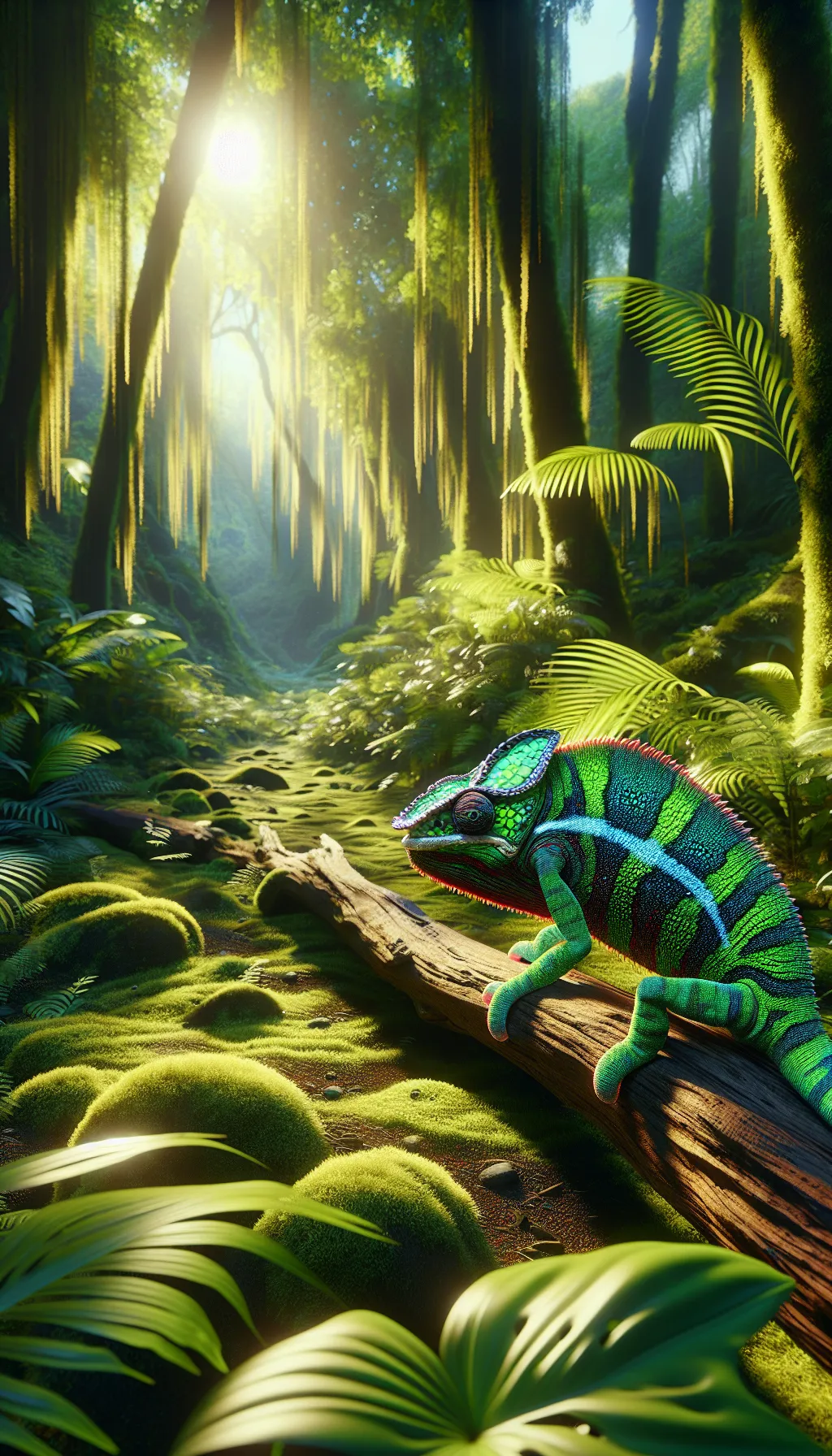The Panther Chameleon
The Panther Chameleon, native to Madagascar, is known for its stunning ability to change color based on its mood and environment. With a vibrant range of colors including red, green, blue, and orange, they are truly a sight to behold. Their large eyes can move independently, providing them with a unique advantage in hunting prey. These chameleons have a prehensile tail they use for balance and climbing.

| Panther Chameleon | |
|---|---|
| Size | Up to 17 inches (45 centimeters) |
| Weight | Up to 0.2 pounds (90 grams) |
| Speed | 10-20mph (16-32km/h) |
| Key Strength | Camouflage |
| Biggest Weakness | Vulnerable to predators |
| Scientific Name | Furcifer pardalis |
| Family | Chamaeleonidae |
| Habitat | Arboreal |
| Geography | Madagascar |
| Diet | Insects, small birds, and fruits |
| Lifespan | 5 years - 7 years |

The Panther Chameleon
The Panther Chameleon, native to Madagascar, is known for its stunning ability to change color based on its mood and environment. With a vibrant range of colors including red, green, blue, and orange, they are truly a sight to behold. Their large eyes can move independently, providing them with a unique advantage in hunting prey. These chameleons have a prehensile tail they use for balance and climbing.
Fun Fact: Panther Chameleons have specialized feet with fused toes that provide them with a strong grip for climbing on branches and vines in their natural habitat.
| Panther Chameleon | |
|---|---|
| Size | Up to 17 inches (45 centimeters) |
| Weight | Up to 0.2 pounds (90 grams) |
| Speed | 10-20mph (16-32km/h) |
| Key Strength | Camouflage |
| Biggest Weakness | Vulnerable to predators |
| Scientific Name | Furcifer pardalis |
| Family | Chamaeleonidae |
| Habitat | Arboreal |
| Geography | Madagascar |
| Diet | Insects, small birds, and fruits |
| Lifespan | 5 years - 7 years |
Panther Chameleon Matchups
We use AI to simulate matchups between the Panther Chameleon and other animals. Our simulation considers size, strength, and natural predatory behaviors to determine the most likely outcome.
Panther Chameleon: Diet, Predators, Aggression, and Defensive Behaviors
What do Panther Chameleons eat?
Panther Chameleons are primarily insectivores, meaning they mainly eat insects such as crickets, flies, worms, and grasshoppers. In the wild, they may also consume small lizards, snails, and even small birds. In captivity, they can be fed a diet of gut-loaded insects and commercial insect powders to ensure they receive proper nutrition.
Do Panther Chameleons have any predators?
Panther Chameleons do have natural predators in their native Madagascar, which include birds of prey, snakes, and small mammals. These predators often target young or smaller chameleons. However, their ability to camouflage themselves and blend in with their surroundings provides them with some protection from predators.
Are Panther Chameleons aggressive?
Panther Chameleons are generally not aggressive towards humans, but they can display territorial and aggressive behavior towards other chameleons, especially males. If two male Panther Chameleons encounter each other, they may engage in dominance displays, such as puffing up their bodies and displaying bright colors, to establish hierarchy.
Do Panther Chameleons fight?
While Panther Chameleons may engage in territorial disputes and dominance displays, they typically do not engage in physical fights. Instead, they use visual displays, such as color changes and body language, to communicate with one another and avoid physical confrontation.
How do Panther Chameleons defend themselves?
Panther Chameleons have several defense mechanisms to protect themselves from predators. Their primary defense is their ability to change colors to blend into their surroundings, making them difficult to spot. Additionally, they have specialized camouflage features, such as zygodactylous feet for climbing, a prehensile tail for balance, and a projectile tongue for catching prey from a distance.
What is Panther Chameleons' biggest weakness in a fight?
Despite their impressive abilities to blend in and defend themselves, Panther Chameleons' biggest weakness in a fight is their relatively fragile bodies. Their bones are thin and hollow, making them susceptible to injuries from physical confrontation. As a result, Panther Chameleons rely more on intimidation tactics and display behaviors to avoid direct physical conflicts.
Fun Fact: Male Panther Chameleons can have elaborate color displays on their bodies, which they use to communicate with other chameleons and to attract potential mates.
Fun Fact: The Panther Chameleon's tongue can extend up to twice its body length, allowing it to catch prey with incredible accuracy and speed.










